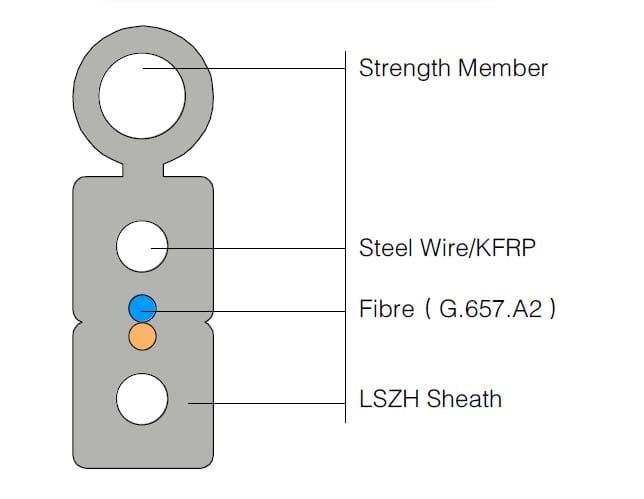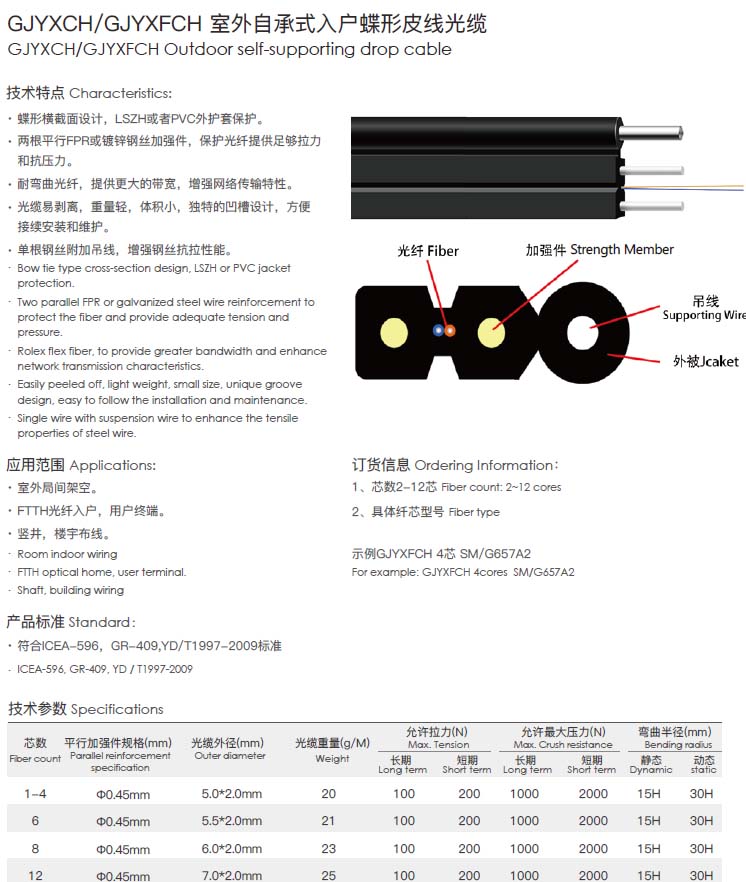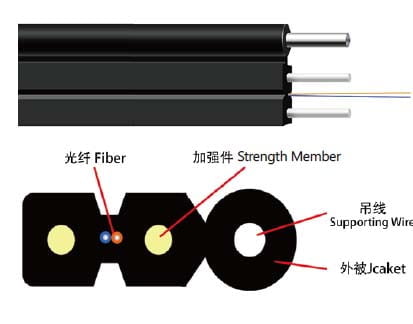


4 Core FTTH Drop Cable Self-Support G.657A2 FRP LSZH GJYXFCH
$0.06
4 Core FTTH Drop Cable Self-Support GJYXFCH SM 9/125 OS2 G657A2 with 2 FRP in Parallel As Strength member A steel wire or KFRP As Strength member LSZH The drop FTTH cables are with flame retardant jacket and with supporting wire, there are strengthen members inside the cables for supporting the whole cables. The optical fiber cable is with special structure so it is easy to pull the fibers out from the cables.
4 Core FTTH Drop Cable Self-Support GJYXFCH SM 9/125 OS2 G657A2 with 2 FRP in Parallel As Strength member A steel wire or KFRP As Strength member LSZH
4 Core FTTH Drop Cable Self-Support GJYXFCH SM 9/125 OS2 G657A2 with 2 FRP in Parallel As Strength member A steel wire or KFRP As Strength member LSZH. FRP With Two parallel Fiber Reinforce Plastic (FRP) strength members with LSZH sheath and 1 or 2 or 4 or… Optical fiber unit is positioned in the center A steel wire or KFRP As Strength member. FTTH out door cable because of Fiber Type Singlemode G.657A has a much greater bandwidth to carry data and less susceptible to interference than common indoor fiber cables because flexibility of Singlemode G.657A1 bendable characteristics. With small diameter, water-resistant, the non-metallic strength member FRP (Fiber-reinforced plastic) can provide lightning protection and anti-electromagnetic interference. 4 Core FTTH Drop Cable Self-Support GJYXFCH SM 9/125 OS2 G657A2 with 2 FRP in Parallel As Strength member A steel wire or KFRP As Strength member LSZH is ideal for outdoor cabling, end users directly cabling, and access network. The optical fiber unit is positioned in the center. Two parallel Fiber Reinforced Plastics (FRP) are placed at the two sides. Then, the cable is completed with a black or white LSZH sheath.
The typical GJYXFCH/GJYXCH self-supporting bow-type drop optical cable consists of GJXFH/GJXH cable and an additional strength member (steel wire or stranded steel wire).
Comply with standard YD/T1997-2009
- Special low-bend-sensitivity fiber provides high bandwidth and excellent communication transmission property.
- Two parallel FRP strength members ensure good performance of crush resistance to protect the fiber.
- Single steel wire as the additional strength member ensure good performance of tensile strength.
- Simple structure, light weight and high practicability.
- Novel flute design. easily strip and splice, simplify the installation and maintenance.
- Low smoke, zero halogen and flame retardant sheath.
1)on fiber type G652D or G657A,Pls note that drop cable usually using G657A Fiber, because G657A Fiber have more small bending radius than G652D,Even both type fiber have same grade attenuation. But Drop cable using for FTTX project, and this project require some point with very small bending radius. If you using G652D will cause too big attenuation or fiber will broke if you bend too small radius .please understand it is very important on this issue.
2)On the center strength member, better using FRP .

FTTH Drop Cable Self-Support GJYXFCH SM 9/125 OS2 G657A2 with 2 FRP in Parallel As Strength member A steel wire or KFRP As Strength member LSZH Jacket Structure
flame-retardant LSZH jacket
FRP strength member
A steel wire or KFRP As Strength member
for FTTH OUT Door cabling.
Drop Cable FTTH
LSZH Low Somoke, Zero Halogen. LSZH Grade A, Flame Resistance Resistant property. Suitability for working to direct sunlight exposure Without Messenger FRP Strength Member, Fiber Reinforced Plastic G657 Singlemode Fiber Optic ITU‐T G657A2 Subcategory, appropriate for a minimum design radius of 7.5 mm.
Marking: OEM
Product Length: 1000 m/Drum
Certificate: Should be included for all Wood packing
Application: Indoor Use
or
2000m/ Wooden Drum
1 Drum/ Carton
Wooden Drum Size: 40cm
(Diameter) * 32cm (Height)
Carton Size: 42*42*34cm
Packaging & Labeling
Package 1 is usually for indoor, light weight cables.wight around 10Kg/Km(1 km Dram or 2 Km Dram)
Package 2 is usually for outdoor, heavy weight cables.
we only attach Test Report on the out package of the cable, but we could also mark as your requirements
| Optical Characteristics: | ||||
| Fiber Sort | Multimode | G.651 | A1a:50/125 | Graded-index fiber |
| A1b:62.5/125 | ||||
| Singlemode | G.652(A、B、C) | B1.1:Conventional fiber | ||
| G.652D | B2: Zero dispersion shifted | |||
| G.655 | B1.2 :Cut- off wavelength shifted | |||
| G.657(A1、A2 、B3) | B4: Main technical data for positive dispersion shifted single-mode fiber |
|||
Other useful information FTTH Drop Cable
GJXH (Metal strength member, LSZH jacket, Non Self-Supporting)
GJXDH (Optical fiber ribbon, Metal strength member, LSZH jacket, Non Self-Supporting)
GJXFH (Non-metal strength member, LSZH jacket, Non Self-Supporting)
GJXFDH (Optical fiber ribbon, Non-metal strength member, LSZH jacket, Non Self-Supporting)
What’s the difference between PVC and LSZH cables
Physically, PVC and LSZH are very different. PVC are very soft; LSZH are more rigid because they contain the flame retardant compound, and they are aesthetically more pleasing. A PVC cable (made of polyvinyl chloride) has a jacket that gives off heavy black smoke, hydrochloric acid, and other toxic gases when it burns. Low Smoke Zero Halogen (LSZH) cable has a flame-resistant jacket that doesn’t emit toxic fumes even if it burns.

FTTH Drop Cable Self-Support GJYXFCH SM 9/125 OS2 G657A2 with 2 FRP in Parallel As Strength member A steel wire or KFRP As Strength member LSZH Jacket Datasheet
The telecommunications industry differentiates between several distinct FTTX configurations. The terms in most widespread use today are:
FTTP (fiber-to-the-premises): This term is used either as a blanket term for both FTTH and FTTB, or where the fiber network includes both homes and small businesses.
FTTH (fiber-to-the-home): Fiber reaches the boundary of the living space, such as a box on the outside wall of a home. Passive optical networks and point-to-point Ethernet are architectures that are capable of delivering triple-play services over FTTH networks directly from an operator’s central office.[2][3]
FTTB (fiber-to-the-building, -business, or -basement): Fiber reaches the boundary of the building, such as the basement in a multi-dwelling unit, with the final connection to the individual living space being made via alternative means, similar to the curb or pole technologies.
FTTD (fiber-to-the-desktop): Fiber connection is installed from the main computer room to a terminal or fiber media converter near the user’s desk.
FTTO (fiber-to-the-office): Fiber connection is installed from the main computer room/core switch to a special mini-switch (called FTTO Switch) located at the user´s workstation or service points. This mini-switch provides Ethernet services to end user devices via standard twisted pair patch cords. The switches are located decentrally all over the building, but managed from one central point.
FTTE / FTTZ (fiber-to-the-telecom-enclosure or fiber-to-the-zone) is a form of structured cabling typically used in enterprise local area networks, where fiber is used to link the main computer equipment room to an enclosure close to the desk or workstation. FTTE and FTTZ are not considered part of the FTTX group of technologies, despite the similarity in name.[4]
FTTF (fiber-to-the-frontage) This is very similar to FTTB. In a fiber to the front yard scenario, each fiber node serves a single subscriber. This allows for multi-gigabit speeds using XG-fast technology. The fiber node may be reverse-powered by the subscriber modem.[5]
FTTdp (Fibre To The Distribution Point) This is very similar to FTTC / FTTN but is one-step closer again moving the end of the fiber to within meters of the boundary of the customers premises in last junction possible junction box known as the “distribution point” this allows for near-gigabit speeds[6]
FTTN / FTTLA (fiber-to-the-node, -neighborhood, or -last-amplifier): Fiber is terminated in a street cabinet, possibly miles away from the customer premises, with the final connections being copper. FTTN is often an interim step toward full FTTH (fiber-to-the-home) and is typically used to deliver ‘advanced’ triple-play telecommunications services.
FTTC / FTTK (fiber-to-the-curb/kerb, -closet, or -cabinet): This is very similar to FTTN, but the street cabinet or pole is closer to the user’s premises, typically within 1,000 feet (300 m), within range for high-bandwidth copper technologies such as wired ethernet or IEEE 1901 power line networking and wireless Wi-Fi technology. FTTC is occasionally ambiguously called FTTP (fiber-to-the-pole), leading to confusion with the distinct fiber-to-the-premises system.
FTTA (fiber-to-the-Antenna) in 3G and 4G BTS
To promote consistency, especially when comparing FTTH penetration rates between countries, the three FTTH Councils of Europe, North America, and Asia-Pacific agreed upon definitions for FTTH and FTTB in 2006,[7] with an update in 2009,[8] 2011[9] and another in 2015.[10] The FTTH Councils do not have formal definitions for FTTC and FTTN.



Reviews
There are no reviews yet.